Politics
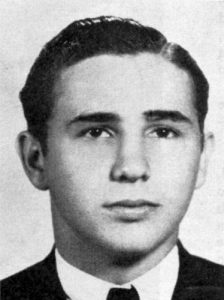 Sometimes, it’s a close call that saves the life of a person, because a difference of inches could have meant the difference between life and death. That was the case for young Corporal Adolf Hitler when he was temporarily blinded on October 14, 1918, by a gas shell that was close enough to temporarily blind him, but unfortunately for the rest of the world, not close enough to kill him. The British shell was part of an attack at Ypres Salient in Belgium, and in the aftermath, Hitler found himself evacuated to a German military hospital at Pasewalk, in Pomerania. Of course, Hitler considered this a great good fortune, with the exception of the temporary blindness. I find myself wishing that the shell had been closer, because the difference of inches could have changed the world, and especially the victims of the Holocaust.
Sometimes, it’s a close call that saves the life of a person, because a difference of inches could have meant the difference between life and death. That was the case for young Corporal Adolf Hitler when he was temporarily blinded on October 14, 1918, by a gas shell that was close enough to temporarily blind him, but unfortunately for the rest of the world, not close enough to kill him. The British shell was part of an attack at Ypres Salient in Belgium, and in the aftermath, Hitler found himself evacuated to a German military hospital at Pasewalk, in Pomerania. Of course, Hitler considered this a great good fortune, with the exception of the temporary blindness. I find myself wishing that the shell had been closer, because the difference of inches could have changed the world, and especially the victims of the Holocaust.
Like many young men of the period, Hitler was drafted for Austrian military service, but when he reported, he was turned down due to lack of fitness. In the summer of 1914, Hitler had moved to Munich. When World War I began, he asked for and received special permission to enlist as a German soldier. It all seemed like a noble thing to do. Hitler was a member of the 16th Bavarian Reserve Infantry Regiment. He traveled to France in October 1914. There, he saw heavy action during the First Battle of Ypres, earning the Iron Cross that December for dragging a wounded comrade to safety. These things rather surprise me, give Hitler’s reputation for thinking only of himself.
Over the course of the next two years, Hitler took part in some of the fiercest struggles of the war, including 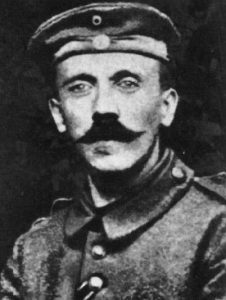 the Battle of Neuve Chapelle, the Second Battle of Ypres and the Battle of the Somme. He was wounded in the leg by a shell blast on October 7, 1916, near Bapaume, France. Following his hospital stay. Hitler was sent to recover near Berlin, after which he returned to his old unit by February 1917. According to Hans Mend, a comrade of Hitler, he was given to rants on the dismal state of morale and dedication to the cause on the home front in Germany. According to Mend, “He sat in the corner of our mess holding his head between his hands in deep contemplation. Suddenly he would leap up, and running about excitedly, say that in spite of our big guns victory would be denied us, for the invisible foes of the German people were a greater danger than the biggest cannon of the enemy.” It would seem that Hitler’s crazed mind was beginning to present itself. As I look at a picture of Hitler as a young man, I wonder what happened to him that changed him so much. Yung Hitler didn’t look like the crazed, evil dictator the world knew
the Battle of Neuve Chapelle, the Second Battle of Ypres and the Battle of the Somme. He was wounded in the leg by a shell blast on October 7, 1916, near Bapaume, France. Following his hospital stay. Hitler was sent to recover near Berlin, after which he returned to his old unit by February 1917. According to Hans Mend, a comrade of Hitler, he was given to rants on the dismal state of morale and dedication to the cause on the home front in Germany. According to Mend, “He sat in the corner of our mess holding his head between his hands in deep contemplation. Suddenly he would leap up, and running about excitedly, say that in spite of our big guns victory would be denied us, for the invisible foes of the German people were a greater danger than the biggest cannon of the enemy.” It would seem that Hitler’s crazed mind was beginning to present itself. As I look at a picture of Hitler as a young man, I wonder what happened to him that changed him so much. Yung Hitler didn’t look like the crazed, evil dictator the world knew
Hitler continued to earn citations for bravery over the next year, including an Iron Cross 1st Class for “personal bravery and general merit” in August 1918 for single-handedly capturing a group of French soldiers hiding in a shell hole during the final German offensive on the Western Front. Then, on October 14, 1918, Hitler received the injury that put an end to his service in World War I. He learned of the German surrender while recovering at Pasewalk. Hitler was furious and frustrated by the news. He said, “I staggered and stumbled back to my 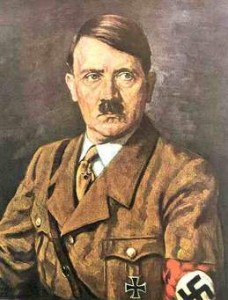 ward and buried my aching head between the blankets and pillow.” Hitler felt he and his fellow soldiers had been betrayed by the German people. I’m amazed that he did not put them in the camps too. In 1941, Hitler as Führer would reveal the degree to which his career and its terrible legacy had been shaped by the World War I, writing that “I brought back home with me my experiences at the front; out of them I built my National Socialist community.”
ward and buried my aching head between the blankets and pillow.” Hitler felt he and his fellow soldiers had been betrayed by the German people. I’m amazed that he did not put them in the camps too. In 1941, Hitler as Führer would reveal the degree to which his career and its terrible legacy had been shaped by the World War I, writing that “I brought back home with me my experiences at the front; out of them I built my National Socialist community.”
When I think of what might have been, but for a difference of inches, I find it very ironic. If that shell had hit just a few inches closer, perhaps Hitler would have died a hero in his nation, before he could become the epitome of evil…to the world, and to many of his own people. I suppose World War I and II, as well as the other wars, would have still happened, but maybe, quite likely, the Holocaust would not have happened. Just a few inches. If only.
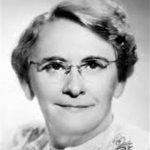
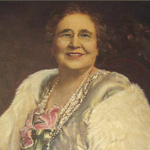 Unfortunately, not every life story is a perfect one. There are among us, who embrace evil, greed, and selfishness, as well as the need to promote themselves as far more important than they are, or ever should be allowed to be. Georgia Tann was purported to be the face of modern adoption practices. She supposedly changed the view of orphan children, from unworthy of better circumstances to simply victims of circumstance who could go on to greatness, if given the chance. She had the backing of many of the prominent members of Memphis society, and officials including Shelby County Juvenile Court Judge Camille Kelley. In reality, Tann operated a horrific human trafficking operation under the name of the Tennessee Children’s Home Society (not to be confused with the legally operated Tennessee Children’s Home) from 1924 to 1950. The non-profit corporation might have been legitimate when first chartered in 1897. Beulah George Tann was born in July 18, 1891, so she was too young to bring her evil into the society when it first began, and didn’t work there when the charter was renewed in 1913, but it was under her leadership that it became an illegal adoption agency.
Unfortunately, not every life story is a perfect one. There are among us, who embrace evil, greed, and selfishness, as well as the need to promote themselves as far more important than they are, or ever should be allowed to be. Georgia Tann was purported to be the face of modern adoption practices. She supposedly changed the view of orphan children, from unworthy of better circumstances to simply victims of circumstance who could go on to greatness, if given the chance. She had the backing of many of the prominent members of Memphis society, and officials including Shelby County Juvenile Court Judge Camille Kelley. In reality, Tann operated a horrific human trafficking operation under the name of the Tennessee Children’s Home Society (not to be confused with the legally operated Tennessee Children’s Home) from 1924 to 1950. The non-profit corporation might have been legitimate when first chartered in 1897. Beulah George Tann was born in July 18, 1891, so she was too young to bring her evil into the society when it first began, and didn’t work there when the charter was renewed in 1913, but it was under her leadership that it became an illegal adoption agency.
Tann preyed upon people who had lost their jobs due to the depression, as well as single mothers, telling them that she could help them by taking the children temporarily, until they could get back on their feet. When the parents tried to reclaim their children, they found out that they had been adopted. The parents tried to fight Tann in court, but the courts rules in favor of the Tennessee Children’s Home Society…but she didn’t stop there. She had her people take children off the streets, and even their own front porches. The children were listed as abused, neglected, or abandoned. Their names and birthdates were changed to make tracking difficult…records were routinely destroyed. She also had parents sign forms they did not understand when their babies were born, often while mothers were still under medication, saying that this would let the county pay for the birth. Parents were then told the babies had died. When their older children were taken away, they found out that they had also signed away the rights to their them too. There were many corrupt officials involved in this. The corruption ran deep, and everyone covered up for everyone else in the ring.
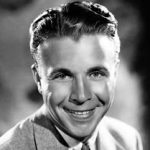
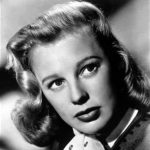
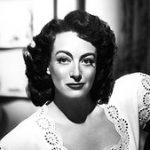
The problem the children faced after being removed from the protection of their parents, who love them; is that the people who take them do not value the heart, mind, and bodies of these children. The children kept there were routinely malnourished, beaten, imprisoned, and abused…in every sense of the word. They were not allowed to go to school, and they were taken to viewing parties so potential…rich parents could take the ones they liked. Tann took children from poor people and gave them to “high-types” of people…for a price, of course. The cost of the adoptions was high and there were additional fees is the child had to be transported to another state. Only the rich could afford them. Tann pocketed the lion’s share of the fees received, and she lived well, while the children often survived on cornmeal mush. It is estimated that over 500 children died in the group homes run by Georgia Tann. Some were buried in mass graves. The final resting place of many others is unknown.
Tann’s rich parents were victims too. They had unknowingly adopted children who shouldn’t have been up for adoption. If they found out what she had done, Tann blackmailed them into silence. Actress, Joan Crawford’s twin daughters Cathy and Cynthia were adopted through the agency. Actors, June Allyson and husband Dick Powell also used the Memphis-based home for adopting a child. Professional wrestler Ric Flair was stolen from his birth mother and placed for adoption. Auto racer Gene Tapia had a son stolen by the agency. A 1950 state investigation found that Tann had arranged for thousands of adoptions under questionable means. State investigators discovered that the Society was a front for a broad black market adoption ring, headed by Tann. They also found record irregularities and secret bank accounts. In some cases, Tann skimmed as much as 80 to 90% of the adoption fees when children were placed out of state. Officials found that Judge Camille Kelley had 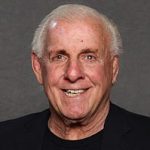
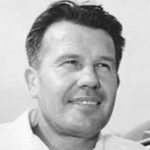 railroaded through hundreds of adoptions without following state laws. Kelley received payments from Tann for her assistance. Tann died in the fall of 1950, before the case could go to trial. Kelley announced that she would retire after 20 years on the bench. Kelley was not prosecuted for her role in the scandal and died in 1955. Over the years that Tann headed up the Tennessee Children’s Home Society, she amassed at least 5,000 victims. The true number will most likely never be known, and in reality, continues to grow with each generation of children born, who will never know their true heritage.
railroaded through hundreds of adoptions without following state laws. Kelley received payments from Tann for her assistance. Tann died in the fall of 1950, before the case could go to trial. Kelley announced that she would retire after 20 years on the bench. Kelley was not prosecuted for her role in the scandal and died in 1955. Over the years that Tann headed up the Tennessee Children’s Home Society, she amassed at least 5,000 victims. The true number will most likely never be known, and in reality, continues to grow with each generation of children born, who will never know their true heritage.
 It seems that before every accepted type of warning system, there is a period of time when the warnings are either ignored by officials or the officials worry that such a warning will cause a panic among the people. In retrospect, however, the officials always wish that they had allowed the warnings to be posted, so that lives could have been saved. I can understand how the idea of mass panic could be a bit scary for officials, and people often don’t act in a way that could produce an orderly evacuation, in which everyone evacuates as if nothing is wrong.
It seems that before every accepted type of warning system, there is a period of time when the warnings are either ignored by officials or the officials worry that such a warning will cause a panic among the people. In retrospect, however, the officials always wish that they had allowed the warnings to be posted, so that lives could have been saved. I can understand how the idea of mass panic could be a bit scary for officials, and people often don’t act in a way that could produce an orderly evacuation, in which everyone evacuates as if nothing is wrong.
David Bernays and Charles Sawyer were two American scientists who were exploring the area around Yungay, Peru. They were climbing nearby Mount Huascarán, when they saw something that alarmed them. They noticed quite a bit of loose bedrock under a glacier. The scientists also knew that the region was prone to earthquakes. The mix of those two things, possible disasters on their own, could be catastrophic if they happened together. Bernays and Sawyer tried to save the residents of Yungay, Peru from the huge avalanche that was a very real possibility.
At the warning, the government became so outraged by the warning the scientists issued, that they ordered the them to take it back or go to prison. That was a big threat, and these were American scientists in a foreign country. I’m sure that the men were justifiably terrified. As a result of the threat and the fear it brought, the two scientists fled the country. Several years later, the men were proven right, when an avalanche killed most of Yungay’s 20,000 residents. I’m sure that being proven right didn’t do much for the two scientists’ feelings of horror at the very disaster that they had so correctly predicted. This was not going to be an “I told you so” moment. It was simply a tragedy…and it could have been prevented, if anyone had listened.
The May 31, 1970 undersea earthquake off the coast of Casma and Chimbote, north of Lima, triggered one of the most cataclysmic avalanches in recorded history. The avalanche wiped out the entire highland town of Yungay and most of its 25,000 inhabitants. Around 3:23pm, local time, while most people were tuned in to the Italy-Brazil FIFA World Cup Match, an earthquake struck the Peruvian departments of Ancash and La Libertad. The quake’s epicenter was located in the Pacific Ocean, where the Nazca Plate is subducted by the South American Plate, and recorded a magnitude of 8.0 on the Richter scale, with an intensity of up to 8 on the Mercalli scale. The quake lasted 45 seconds, and crumbled adobe homes, bridges, roads and schools across 83,000 square kilometers, an area larger than Belgium and the Netherlands combined. It was registered as one of the worst earthquakes ever to be experienced in South America. Damage and casualties were reported as far 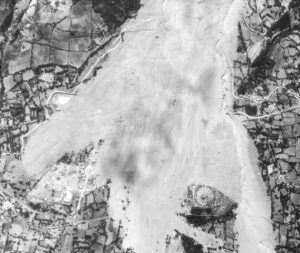 as Tumbes, Iquitos and Pisco, as well as in some parts of Ecuador and Brazil…but in Yungay, a small highland town in the picturesque Callejon de Huaylas, founded by Domingo Santo Tomás in 1540, the earthquake triggered an even greater calamity.
as Tumbes, Iquitos and Pisco, as well as in some parts of Ecuador and Brazil…but in Yungay, a small highland town in the picturesque Callejon de Huaylas, founded by Domingo Santo Tomás in 1540, the earthquake triggered an even greater calamity.
Following the quake, the glacier on the north face of Mount Huascarán broke free, causing 10 million cubic meters of rock, ice and snow to break away and tear down its slope at more than 120 miles, per hour. As it thundered down toward Yungay, and the town of Ranrahirca on the other side of the ridge, the wave of debris picked up more glacial deposits and began to spit out mud, dust, and boulders. By the time it reached the valley, just three minutes later, the 3,000 feet wide wave was estimated to have consisted of about 80 million cubic meters of ice, mud, and rocks. Within moments, what was Yungay and its 25,000 inhabitants, many of whom had rushed into the church to pray after the earthquake struck, were buried and crushed by the landslide. The smaller village of Ranrahirca was buried as well, the second time in a decade, but it is the image of lone surviving palm trees in the Yungay cemetery that is burned into Peru’s memory.
“We were on our way from Yungay to Caraz when the earthquake struck,” survivor Mateo Casaverde recalls. “When we stepped out of the car, the earthquake was almost over. Then we heard a deep, low rumble, something distinct from the noise an earthquake makes, but not too different. It came from the Huascarán. Then we saw, half-way between Yungay and the mountain, a giant cloud of dust. Part of the Huascarán was coming toward us. It was approximately 3:24pm. Where we were, the only place that offered us relative security, was the cemetery, built upon an artificial hill, like a pre-Incan tomb. We ran approximately 100 meters before we got to the cemetery. Once I reached the top, I turned to see Yungay. I could clearly see a giant wave of gray mud, about 60 meters high. Moments later, the landslide hit the cemetery, about five meters below our feet. The sky went dark because of all the dust, mostly from all of the destroyed homes. We turned to look, and Yungay, as well as its thousands of inhabitants, had completely disappeared.”
The reported death toll from what came to be known as Peru’s Great Earthquake totaled more than 74,000 people. About 25,600 were declared missing, over 143,000 were injured and more than one million left homeless. The city of Huaraz was rubble, the valley buried in mud, and coastal towns such as Casma were also shaken to the ground. In Yungay, only some 350 people survived, including the few who were able to climb to the town’s elevated step-like cemetery. Built between 1892 and 1903, the cemetery was designed by Swiss architect Arnoldo Ruska, who also died as a result of the landslide. Among the survivors were 300 children, who had been taken to the circus at the local stadium, set on higher ground and on the outskirts of the town.
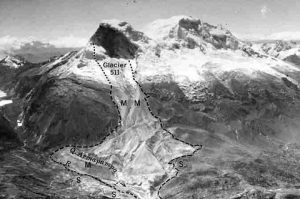 Today, Yungay is a national cemetery and the Huascarán’s victims are still vividly remembered. Because the Peruvian government has forbidden excavation in the area, crosses and tombs mark the spots where homes once stood, engraved with the names of those never found. A crushed intercity bus, four of the original palm trees that once crowned the city’s main plaza and remnants of the cathedral still stand. Though life goes on and a new Yungay has since been rebuilt, a few miles away from the original city, Peru does not forget. In 2000, in memory of the victims of the deadliest seismic disaster in the history of Latin America, the government declared May 31 “Natural Disaster Education and Reflection Day.”
Today, Yungay is a national cemetery and the Huascarán’s victims are still vividly remembered. Because the Peruvian government has forbidden excavation in the area, crosses and tombs mark the spots where homes once stood, engraved with the names of those never found. A crushed intercity bus, four of the original palm trees that once crowned the city’s main plaza and remnants of the cathedral still stand. Though life goes on and a new Yungay has since been rebuilt, a few miles away from the original city, Peru does not forget. In 2000, in memory of the victims of the deadliest seismic disaster in the history of Latin America, the government declared May 31 “Natural Disaster Education and Reflection Day.”
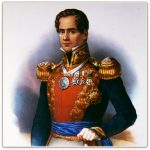
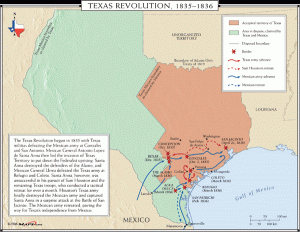 Since the 17th century, Texas, or Tejas as the Mexicans called it, had technically been a part of the Spanish empire. However, there were only about 3,000 Spanish-Mexican settlers in Texas, even as late as the 1820s, and Mexico City’s hold on the territory was very weak. Tensions were growing between Mexico and Texas, and on October 2, 1835, the area erupted into violence when Mexican soldiers attempted to disarm the people of Gonzales. People just don’t take kindly to having their guns taken away in any era, I guess. The citizens of Texas chose a war for independence of allowing the government to take their guns.
Since the 17th century, Texas, or Tejas as the Mexicans called it, had technically been a part of the Spanish empire. However, there were only about 3,000 Spanish-Mexican settlers in Texas, even as late as the 1820s, and Mexico City’s hold on the territory was very weak. Tensions were growing between Mexico and Texas, and on October 2, 1835, the area erupted into violence when Mexican soldiers attempted to disarm the people of Gonzales. People just don’t take kindly to having their guns taken away in any era, I guess. The citizens of Texas chose a war for independence of allowing the government to take their guns.
Mexico had just won it’s own independence from Spain in 1821. At this point, Mexico welcomed large numbers of Anglo-American immigrants into Texas. They were hoping that these citizens would become loyal Mexican citizens, thereby keeping the territory from falling into the hands of the United States. During the next decade men like Stephen Austin brought more than 25,000 people to Texas, most of them Americans. But while these emigrants legally became Mexican citizens, they continued to speak English, formed their own schools, and had closer trading ties to the United States than to Mexico.
The situation exacerbated in 1835, the president of Mexico, Antonio Lopez de Santa Anna, overthrew the constitution and appointed himself dictator. Recognizing that the “American” Texans were likely to use his rise to power as an excuse to secede, Santa Anna ordered the Mexican military to begin disarming the Texans whenever possible. He underestimated the people. His attempt to disarm proved more difficult than he could have ever imagined, and the situation exploded on that October day in 1835.
That day, the Mexican soldiers were attempting to take a small cannon from the village of Gonzales. To their surprise, they encountered much stiffer resistance than they ever thought possible from a hastily assembled militia of Texans. After a rather brief fight, the Mexicans retreated and the Texans kept their cannon. The determined Texans would continue to battle Santa Ana and his army for another year and a half before winning their independence and establishing the Republic of Texas. This truly goes to show that a nation, whose citizens are armed, is much more likely to be able to fend off their enemies…even if that enemy is a tyrannous government; than an nation of disarmed citizens. Yes, the ensuing war lasted for another year and a half, but 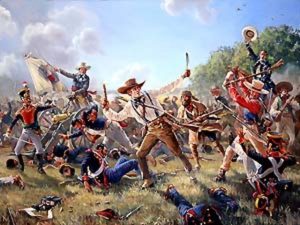
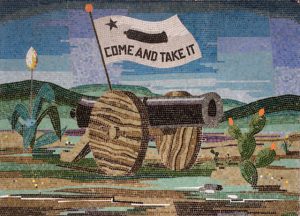 the people won their independence in the end. They later went on to become a part of the United States, and they continue to carry their guns to this day. The people of Texas are just as adamant about their right to bear arms today as they were in 1835, as are a good number of their fellow Americans. It’s a fight that would not likely be won by the government today either. The American people won’t accept the loss of guns without a fight of epic proportions!!
the people won their independence in the end. They later went on to become a part of the United States, and they continue to carry their guns to this day. The people of Texas are just as adamant about their right to bear arms today as they were in 1835, as are a good number of their fellow Americans. It’s a fight that would not likely be won by the government today either. The American people won’t accept the loss of guns without a fight of epic proportions!!
 Every time I learn anything about Adolf Hitler, I am stunned that so much evil could exist in one man. World War II technically started when Adolf Hitler invaded Poland. Hitler told his men that “it did not matter who was right or wrong, that in fighting a war, coming out triumphant is the only thing that counted.” He urged his men to have no sympathy for their opponent. On September 1, 1939, Hitler ordered the invasion of Poland, by ordering the attack of defenseless civilians. In this way, they put the citizens in a state of shock. The sky was dark and there were dead bodies everywhere. Once Germany invaded Poland, it opened a door to allow the Soviets to also invade Poland. Of course, this was not exactly what either country wanted.
Every time I learn anything about Adolf Hitler, I am stunned that so much evil could exist in one man. World War II technically started when Adolf Hitler invaded Poland. Hitler told his men that “it did not matter who was right or wrong, that in fighting a war, coming out triumphant is the only thing that counted.” He urged his men to have no sympathy for their opponent. On September 1, 1939, Hitler ordered the invasion of Poland, by ordering the attack of defenseless civilians. In this way, they put the citizens in a state of shock. The sky was dark and there were dead bodies everywhere. Once Germany invaded Poland, it opened a door to allow the Soviets to also invade Poland. Of course, this was not exactly what either country wanted.
Before the end of the month, on September 29, 1939, Germany and the Soviet Union agree to divide control of occupied Poland roughly along the Bug River, with the Germans taking everything west, and the Soviets taking everything east. The people of Poland were given away like slaves. In addition, as a follow-up to the Molotov-Ribbentrop Pact, which was also known as the Hitler-Stalin Pact, a non-aggression treaty was created between the two huge military powers of Germany and the USSR. The German foreign minister, Joachim von Ribbentrop met with his Soviet counterpart, VM Molotov, to sign the German-Soviet Boundary and Friendship Treaty. Of course, the “friendship” did not extend to the Polish people.
As in normal in any contract, there was “fine print” in this agreement too. The fine print of the original non-aggression pact had promised the Soviets a slice of eastern Poland. It was to be a small part, simply a matter of agreeing where to draw the lines. Joseph Stalin, Soviet premier and dictator, personally drew the line that partitioned Poland. He originally wanted it drawn at the River Vistula, just west of Warsaw. In the end, he agreed to pull it back east of the capital and Lublin, giving Germany control of most of Poland’s most heavily populated and industrialized regions. In exchange, Stalin wanted Lvov, and its rich oil wells, and Lithuania, which sits atop East Prussia. Germany was fine with that, because now they had 22 million Poles, “slaves of the Greater German Empire,” at its disposal…and Russia had a western buffer zone.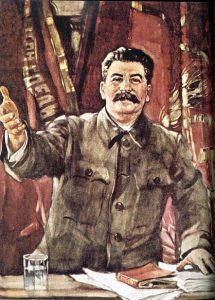
On this same day, the Soviet Union also signed a Treaty of Mutual Assistance with the Baltic nation of Estonia, giving Stalin the right to occupy Estonian naval and air bases. What was thought to be a buffer zone, seems more like a land grab to me. A similar treaty would later be signed with Latvia. These nations really didn’t seem to realize what they were getting into. Eventually, Soviet tanks rolled across these borders, in the name of “mutual assistance,” placing the Baltic States under the rule of the USSR for decades to come. These so called treaties were once again merely the realization of more fine print from the Ribbentrop-Molotov Pact, giving Stalin more border states as buffer zones, and protecting Russian territory where the Bolshevik ideology had not been enthusiastically embraced from intrusion by its western neighbor, namely its non-aggression partner Germany. The highly vulnerable Baltic nations had no say in any of these arrangements. They were merely annexed…by force in a huge Soviet land grab.
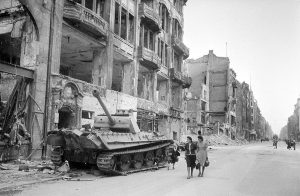 World War II took it’s toll on many people. The soldiers, families at home, and probably unknown to the people of the Allied nations…the German people. When we think of the Nazis, we think of an entire country so filled with hate for the Jewish people…as well as any nationality that was different that the Nazi white people. The reality is that while there were a relatively small number of Hitler’s puppets to actually embraced the thinking and the hatred of Hitler; there were also a great many of the German people who were not Nazis, nor did they agree with anything that Hitler did or believed. They were good and decent people, who valued life, and just wanted to work hard, and live their lives in peace and happiness.
World War II took it’s toll on many people. The soldiers, families at home, and probably unknown to the people of the Allied nations…the German people. When we think of the Nazis, we think of an entire country so filled with hate for the Jewish people…as well as any nationality that was different that the Nazi white people. The reality is that while there were a relatively small number of Hitler’s puppets to actually embraced the thinking and the hatred of Hitler; there were also a great many of the German people who were not Nazis, nor did they agree with anything that Hitler did or believed. They were good and decent people, who valued life, and just wanted to work hard, and live their lives in peace and happiness.
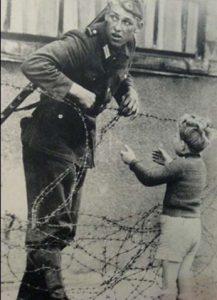
These post-war German citizens were faced with a new and strange kind of post-war reality. The country suffered from collective PTSD. Said one German citizen, “We were a broken, defeated, extinguished people in 1045. 60 million human beings suffered from PTDS. And Knowing that not only did you lose…but also that you were on the wrong side. On the wrong side of morality, of humanity, of history. We were the bad guys. There was no pride. Just the knowledge that we were at rock bottom, and rightfully so.”
As American and Allies, it is hard for us to accept their feelings of remorse. I’m sure that the Jews, Gypsies, and other persecuted races had an even harder time feeling bad for the German people…at least, not unless they were some of the German citizens who escaped from Germany along with other refugees, or those who helped their Jewish or Gypsy counterparts to escape or to survive. One of those sympathizers who lived, warned his children and grandchildren, saying, “Don’t forget, but don’t tell anyone about this.” He was so ashamed and so angry, still, 40, 50 years 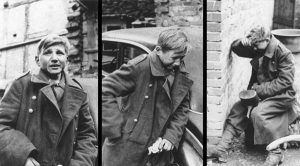 later. He said that the Nazis had taken the best years of his life, saying, “We must look out for them, it can happen again. Beware, pay attention to politics! Speak up! We couldn’t stop them, maybe you can, next time.” The man hammered these things into his grandchild’s brain, over and over and over. He knew the dangers of complacency where politics is concerned. He knew that if they take your guns you are helpless. He knew that if evil people get in office, the danger grows exponentially. He had seen it…first hand. It is a lesson many people today need to learn. It could happen again, if we aren’t vigilant.
later. He said that the Nazis had taken the best years of his life, saying, “We must look out for them, it can happen again. Beware, pay attention to politics! Speak up! We couldn’t stop them, maybe you can, next time.” The man hammered these things into his grandchild’s brain, over and over and over. He knew the dangers of complacency where politics is concerned. He knew that if they take your guns you are helpless. He knew that if evil people get in office, the danger grows exponentially. He had seen it…first hand. It is a lesson many people today need to learn. It could happen again, if we aren’t vigilant.
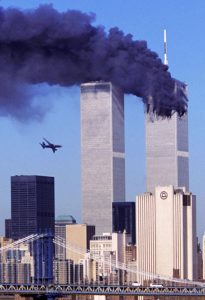
 It hardly seems possible that 18 years have passed since our nation was brutally attacked on our own soil by Al-Qaeda terrorists, and yet sometimes it seems like so many people who are adults now, don’t really remember 9-11, so they don’t understand the importance. It’s not an unusual thing, I guess, because they were only told about what happened. It might seem like a movie, more than a reality. Nevertheless, it did happen. On that dreadful day, a series of four coordinated terrorist attacks by the Islamic group, Al-Qaeda were carried out against the United States on the morning of Tuesday, September 11, 2001. The attacks killed 2,996 people, injured over 6,000 others, and caused at least $10 billion in infrastructure and property damage. Additional people died of 9/11-related cancer and respiratory diseases in the months and years following the attacks. We, the people of the United States, sat stunned in front of our television sets, trying to grasp what had happened. We were shocked, angry, and terribly grieved. We vowed never to forget. And most of us have not forgotten.
It hardly seems possible that 18 years have passed since our nation was brutally attacked on our own soil by Al-Qaeda terrorists, and yet sometimes it seems like so many people who are adults now, don’t really remember 9-11, so they don’t understand the importance. It’s not an unusual thing, I guess, because they were only told about what happened. It might seem like a movie, more than a reality. Nevertheless, it did happen. On that dreadful day, a series of four coordinated terrorist attacks by the Islamic group, Al-Qaeda were carried out against the United States on the morning of Tuesday, September 11, 2001. The attacks killed 2,996 people, injured over 6,000 others, and caused at least $10 billion in infrastructure and property damage. Additional people died of 9/11-related cancer and respiratory diseases in the months and years following the attacks. We, the people of the United States, sat stunned in front of our television sets, trying to grasp what had happened. We were shocked, angry, and terribly grieved. We vowed never to forget. And most of us have not forgotten.
Still, with time comes acceptance. Not that I think that is a good thing, because with acceptance comes complacency. We feel like we can’t change anything, so the best solution is to simply get along. Don’t rock the boat. Try to live together in peace. It all sounds so loving, so…Christian. Unfortunately, the only ones that are trying to “get along and live together in peace,” are the Christians, and maybe the Jews, who have been through such things before, and are getting tired of being the target of slaughter. But, should we be trying to get along with the devil? We have seen the evil that comes with these hateful people who target innocent people who are just trying to live their lives. The don’t care about living in peace with us!! The only want us to comply with their demands.
I have seen so many people saying that they miss 9/12, and I think I agree with them. Yes that horrific day had happened…the unthinkable was in our midst. We were scratching through the rubble, trying to find yet one more alive, though not many would come out of the rubble. The survivors were, for the most part, those who managed to escape before the towers came down. Still, on 9/12, there was something else…there was determination, anger, and love for our fellow man. We were determined to rise out of the ashes, and take back our Pre-9/11 lives, to catch those who did this, and make them pay for what they had done. And we did!!
But then, as the years went by, we tried to get along, hoping that this would never happen again…an impossible feat. Our “get along” spirit did not stop other attacks. We began to hear of places like Benghazi, and 
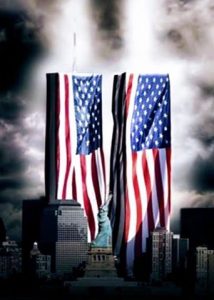 even the attack on the US Embassy in Kabul, Afghanistan this morning. The “get along” spirit wasn’t…isn’t working. They hate us simply because we are Christians and Jews, Americans…free people, who don’t believe as they do. September 11, 2001 was a horrible day, very likely the worst in the history of the United States, but I agree with so many others who say they miss 9/12, because on that day, we were no longer the “sleeping giant.” We woke up and realized that we can’t be complacent, because they will kill those who sit idly by and do nothing. We must either continue to fight for our freedom…or we will lose our freedom. We must begin again to recognize our enemy…foreign or domestic. The war hasn’t ended. It continues. We must fight for our freedoms.
even the attack on the US Embassy in Kabul, Afghanistan this morning. The “get along” spirit wasn’t…isn’t working. They hate us simply because we are Christians and Jews, Americans…free people, who don’t believe as they do. September 11, 2001 was a horrible day, very likely the worst in the history of the United States, but I agree with so many others who say they miss 9/12, because on that day, we were no longer the “sleeping giant.” We woke up and realized that we can’t be complacent, because they will kill those who sit idly by and do nothing. We must either continue to fight for our freedom…or we will lose our freedom. We must begin again to recognize our enemy…foreign or domestic. The war hasn’t ended. It continues. We must fight for our freedoms.
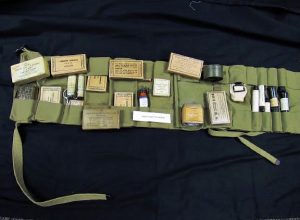 During World War II, if a man was a conscientious objector, things were…difficult. Things like that were not an automatic get out of the war card. Unless they had some necessary skill that would keep them stateside or in an office, they were signed up as a medic. Most of those men thought that was a good place for them, since the would be saving lives and not taking them, but I’m not sure who got it worse. The infantry or the medics.
During World War II, if a man was a conscientious objector, things were…difficult. Things like that were not an automatic get out of the war card. Unless they had some necessary skill that would keep them stateside or in an office, they were signed up as a medic. Most of those men thought that was a good place for them, since the would be saving lives and not taking them, but I’m not sure who got it worse. The infantry or the medics.
The men of the infantry usually considered the conscientious objectors to be cowards. That is not really the way a guy wanted to go into the army, but if they were seriously conscientious objectors, it was a calling they took seriously. 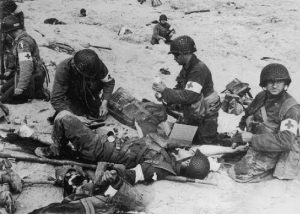 It was not, however, an easy job or the easy way out of combat. The difference between the infantrymen and the medics was that during combat, the infantrymen did their best to stay down, so the weren’t hit. The medics, on the other hand, ran into the fire to treat the wounded, and bring in the dead. It was no easy job.
It was not, however, an easy job or the easy way out of combat. The difference between the infantrymen and the medics was that during combat, the infantrymen did their best to stay down, so the weren’t hit. The medics, on the other hand, ran into the fire to treat the wounded, and bring in the dead. It was no easy job.
The medics, like most soldiers coming into the army were young men…boys really. They were often 18 or 19 years old. The infantrymen had plenty of names for them. None of them were nice…or complimentary, but the medics that stayed medics…the ones who ran into the fire to care for a wounded soldier were given new names. They were finally called medic…or more often Doc. And they were respected. They were also called hero, brave, courageous, and other respectful names. The 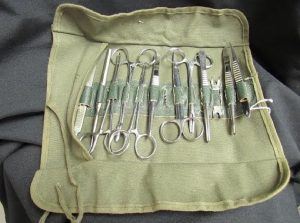 medics were not given the $10.00 per month extra that combat soldiers were given. That made the infantrymen furious. They collected money from each other to provide combat pay for their medics. The men refused to have their medics receive less.
medics were not given the $10.00 per month extra that combat soldiers were given. That made the infantrymen furious. They collected money from each other to provide combat pay for their medics. The men refused to have their medics receive less.
World War II saw eleven medics who received the Medal of Honor…as well as other medals. These men were wounded taking care of the men, and they were even killed saving the lives of the men in their care. These men were heroes, just like their counterparts in the infantry, and there isn’t an infantryman that ever fought, who would disagree.
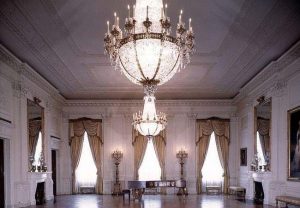 With the new school year just beginning, the reality is that the year’s end will arrive in incredibly short order. Football, basketball, and track will be over, and before we know it, the high school students are getting ready for prom again. Everyone wants their prom to be that wonderful dance that is unforgettable…one that they can carry the memories of forever. Proms are usually held in the school gym, or maybe at an events center, and on rare occasions, a hotel, but in 1975, in Washington DC, was held what could only be called the ultimate prom!! And don’t think your school could duplicate this particular prom, because they couldn’t. This particular prom was held at the White House!! It was the only prom ever to be held at the executive mansion, which makes it an odd event in White House social history.
With the new school year just beginning, the reality is that the year’s end will arrive in incredibly short order. Football, basketball, and track will be over, and before we know it, the high school students are getting ready for prom again. Everyone wants their prom to be that wonderful dance that is unforgettable…one that they can carry the memories of forever. Proms are usually held in the school gym, or maybe at an events center, and on rare occasions, a hotel, but in 1975, in Washington DC, was held what could only be called the ultimate prom!! And don’t think your school could duplicate this particular prom, because they couldn’t. This particular prom was held at the White House!! It was the only prom ever to be held at the executive mansion, which makes it an odd event in White House social history.
Our president at the time was Gerald Ford, and he had a 17 year old daughter named Susan. Like most daughters, Susan knew that her daddy wanted to make her happy. So, she asked him if her high school could hold their prom at the White House. It was the first and only prom ever to be held there…and not something that is likely to happen again. Susan went to school at the Holton-Arms school. The prom was held on March 31, 1975, and President and Mrs Ford were on their way from Belgium to Spain as part of a diplomatic tour of Europe. In their place was the president’s sister-in-law, Janet Ford, “a small figure in a white lace dress, casting 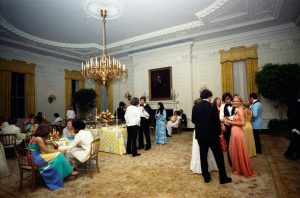 a tolerant but observant eye on the proceedings.”
a tolerant but observant eye on the proceedings.”
Over forty years later, the students who attended the regal prom still carry those wonderful memories of a very special prom that could never be equaled. They even got to take a sunset cruise on the presidential yacht. Many parties have been held at the White House, but none quite like this one. The White House was rockin’ that Saturday, with Susan Ford. her classmates and their dates, dancing the bump and the hustle in the East Room until 1:00am. Susan had been a student at the Holton-Arms School, an academy for girls in Bethesda, Maryland, since her freshman year. “The members of the class of 1975 paid the cost of the prom…$1,300, after raising funds at bake sales and school fairs. Tablecloths were made out of floral pink and yellow sheets. The menu included Swedish meatballs and quiche, as well as a nonalcoholic punch made of tea, lemonade, soda, grape juice, and sugar. Susan and her classmates assembled the centerpieces, candles in a setting of daisies, tulips, lilies, sweet peas, and ming fern.”
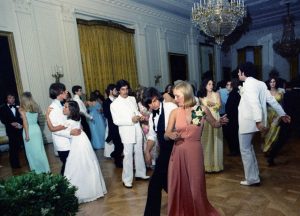 “The girls wore long dresses, light makeup, casual hairdos, and, in many cases, orchid corsages,” the Associated Press reported. “Many of their escorts, in black or white tuxedos, wore boutonnieres and below-the-collar length hair.” “Susan, at that age, was strikingly beautiful,” says Sally Alexander, a retired English teacher at Holton-Arms, who was one of six chaperones. “And it’s a great deal of fun to watch a bunch of beautiful young girls with handsome young men, all dressed up. They were clearly excited about being where they were, but they were not uncomfortably awed. It was a beautiful affair.” And of course, the media was there to document the entire historic prom. So, if you want your prom to be this cool, you had better start planning now…or maybe several years ago.
“The girls wore long dresses, light makeup, casual hairdos, and, in many cases, orchid corsages,” the Associated Press reported. “Many of their escorts, in black or white tuxedos, wore boutonnieres and below-the-collar length hair.” “Susan, at that age, was strikingly beautiful,” says Sally Alexander, a retired English teacher at Holton-Arms, who was one of six chaperones. “And it’s a great deal of fun to watch a bunch of beautiful young girls with handsome young men, all dressed up. They were clearly excited about being where they were, but they were not uncomfortably awed. It was a beautiful affair.” And of course, the media was there to document the entire historic prom. So, if you want your prom to be this cool, you had better start planning now…or maybe several years ago.

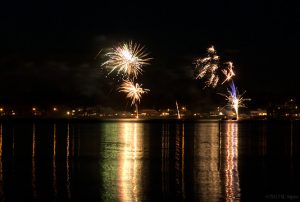 For many years, my husband, Bob Schulenberg and I have gone to the Black Hills to celebrate Independence Day. It has been our tradition for about 30 years. This year, things got changed up a bit. Our daughter, Amy Royce and her husband Travis invited us to come to Washington to spend the holiday with them. We will be watching the fireworks display at Semiahmoo Bay on the 4th. Bob and I went there a couple of years ago when we spent Thanksgiving with Amy’s family. The bay is beautiful, and I’m sure it will be even more fun in the summertime warmth…although it wasn’t very cold in November. We have never seen fireworks set off over water, so that will definitely be something new, and something about which we are very excited.
For many years, my husband, Bob Schulenberg and I have gone to the Black Hills to celebrate Independence Day. It has been our tradition for about 30 years. This year, things got changed up a bit. Our daughter, Amy Royce and her husband Travis invited us to come to Washington to spend the holiday with them. We will be watching the fireworks display at Semiahmoo Bay on the 4th. Bob and I went there a couple of years ago when we spent Thanksgiving with Amy’s family. The bay is beautiful, and I’m sure it will be even more fun in the summertime warmth…although it wasn’t very cold in November. We have never seen fireworks set off over water, so that will definitely be something new, and something about which we are very excited.
Celebrating our nation’s independence has always been a favorite holiday for Bob and me. We love everything about it. The fireworks take my thoughts back to history lessons, of the Revolutionary War. The rockets shot at ships, and the fighting that took place because we were a nation ready to be our own country. The fighting was sometimes brutal, but it was necessary. The patriots willingly gave their lives for the cause of independence. The fighting took place on land and water, and yet we have never seen fireworks over the water…until now. In my mind, I can see the ships from the Revolutionary War out in the bay. I can imagine the fireworks are the rockets, and the war is real. Nevertheless, I am glad that it isn’t really real, because I would not want our soldiers to have to relive that, but I can feel like a mouse in the corner, watching as history unfolds in front of my eyes…at least I can imagine it.
Of course, the fireworks aren’t the real thing, but rather just reminder of what our nation and the soldiers who fought for our independence, went through. My imagination of happened is just that…a figment of my imagination, because those events are long in the past. Still, I don’t believe that we should ever forget the lessons of war. There is always a reason we go to war…a wrong that must be made right, tyranny that must be stopped, killing that must be squashed, and slaves who must be made free. Good nations don’t go to war for 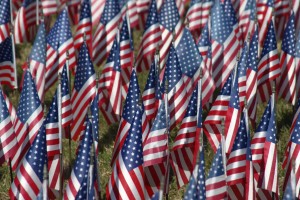
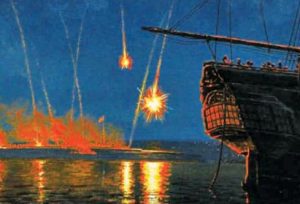 evil purposes. I believe that the most important lesson to be taken away from any war, is that we must never trust our enemies, and even more importantly, we must never allow the enemy to infiltrate our nation and our government. Happy Independence Day to our great nation…the United States of America. Forever may our flag fly and forever may our nation stand.
evil purposes. I believe that the most important lesson to be taken away from any war, is that we must never trust our enemies, and even more importantly, we must never allow the enemy to infiltrate our nation and our government. Happy Independence Day to our great nation…the United States of America. Forever may our flag fly and forever may our nation stand.

